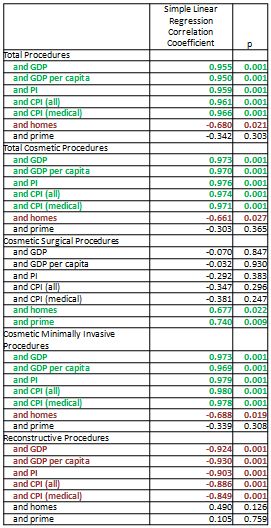|
Back to 2011 Posters
An analysis of leading, lagging, and coincident economic indicators in the United States and its relationship to the volume of plastic surgery procedures performed
Ian C. Hoppe, BA, Craig Pastor, MD.
New Jersey Medical School - UMDNJ, Newark, NJ, USA.
BACKGROUND: As physician compensation and reimbursement tightens throughout the United States it is important for physicians to be aware of the influence that the economic environment has on the unique medical field of plastic and reconstructive surgery. While academic-based plastic surgeons may be less prone to the effects of the economy, community-based plastic surgeons, whose services are frequently viewed as a luxury product, are likely to directly see the impact of the economic environment on their practices. This study will attempt to determine a relationship between the volume of different plastic surgical procedures and different economic indicators. Leading indicators, those that tend to change ahead of the economy, include issuance of new building permits. Lagging indicators, those that tend to change after the economy, include Consumer Price Index (CPI) and the average prime rate charged by banks. Coincident indicators, those that tend to change with the economy, include Gross Domestic Product (GDP) and personal income.
METHODS: Information from the American Society of Plastic Surgeons’ annual reports on plastic surgery statistics available on the internet, (http://www.plasticsurgery.org/Media/Statistics.html) was collected from the year 2000 through 2010. Information regarding the total number of reconstructive, cosmetic surgical, and cosmetic minimally invasive procedures was collected. Information on the GDP was collected from data.worldbank.com. Data on personal income was collected from the Bureau of Economic Analysis (http://www.bea.gov/) for the same time period. CPI information was collected from data.bls.gov. Information on new building permits issued was collected from www.census.gov. The average prime rate charged by banks was collected from federalreserve.gov. Simple linear regression was utilized to determine the relationship between variables. A significance level of 5% was utilized.
RESULTS: The results of simple linear regression are shown in the table. Variables highlighted in green demonstrated a significant positive relationship. Variables highlighted in maroon demonstrated a significant negative relationship.
CONCLUSIONS: This preliminary study demonstrated a relationship between several economic indicators and the volume of different classifications of plastic surgical procedures performed. Total cosmetic surgical procedures was related only to the number of new home building permits issued and the average prime rate charged by banks, leading and lagging economic indicators, respectively. This implies that the decision to undergo a cosmetic surgical procedure is something that may be planned for a long time during good economic times. In addition, cosmetic minimally invasive procedures were related to GDP, personal income, and CPI. GDP and personal income represent coincident indicators and CPI represents a lagging indicator. This implies that the decision to undergo a minimally invasive procedure may be decided on relatively quickly during good economic times. More investigation into relationships between variables and procedures needs to be performed. 
Back to 2011 Posters
|







